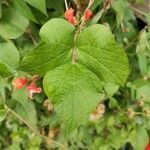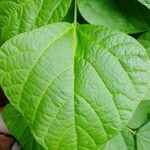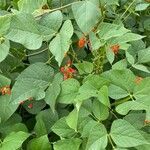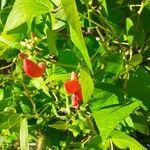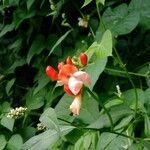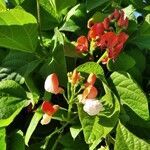Perennial herbs, twining, usually annual crop in temperate zone. Stems pubescent or glabrous. Stipules small, inconspicuous; leaflets ovate or obovate-rhombic, 7.5-12.5 × 7.5-12.5 cm or more, pubescent or glabrous on both surfaces, apex acuminate or slightly obtuse. Racemes longer than leaves, several flowered at top of rachis. Bracteoles oblong-lanceolate, ca. as long as calyx or slightly longer. Calyx broadly campanulate, glabrous or sparsely pilose; teeth shorter than tube, upper lip triangular. Corolla generally scarlet, occasionally white or variegated (red and white), 1.5-2 cm. Legumes falcate-oblong, (5-)16(-30) × ca. 1.5 cm. Seeds deep purple with red spots, black, or red, rarely white, broadly oblong, 1.8-2.5 × 1.2-1.4 cm. Fl. Apr-Jul.
Climbing perennial herb; stems moderately hairy, particularly in upper parts. Lvs sparsely to moderately hairy, especially on petioles; leaflets broadly ovate to deltoid, acute, entire, 30-100-(120) mm long; stipules ovate-triangular, c. 3-6 mm long; stipels narrower than stipules, 2-5 mm long. Infl. racemose, = or > lvs, (3)-6-20-flowered, with numerous bracteoles. Pedicels ± = fls. Calyx sparsely hairy; calyx teeth much < tube. Corolla usually scarlet, sometimes white, 15-30 mm long; beak of keel forming c. 11/2 turns of a spiral. Pod glabrous, brown, oblong and usually somewhat curved, 2-10-seeded, 10-30 cm long; seeds large, variable in shape and colour.
A climbing bean. It is a robust plant and keeps growing from year to year by re-growing from the fattened root. The stems are often hairy. It grows 1.8-2.4 m high. It can spread 1.8-2.4 m wide. It twines around a trellis. The leaves are compound and have three leaflets. The flowers are bright red. They are in clusters 2.5 cm long. The pods are long (30 cm) and with a wavy edge. The seeds are large and can be several different colours. It sometimes has a root tuber.
Two cult. spp., P. vulgaris L., the common bean, and P. coccineus L., the scarlet runner, occasionally escape but apparently never persist.
